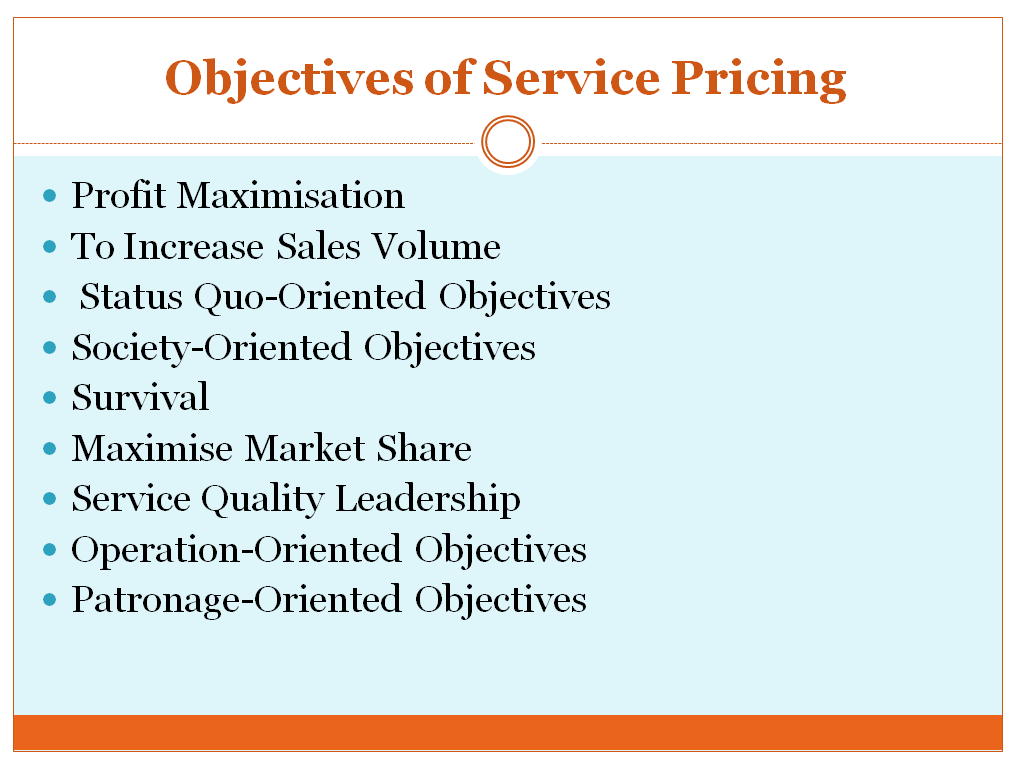Table of Contents:-
- What is Pricing of Services?
- Objectives of Service Pricing
- Components of Service Pricing
What is Pricing of Services?
The pricing of services differs from the pricing of goods in many ways. In the manufacturing sector, price is referred to by a single name, whereas it takes different characters in the services sector.
For example, The price charged for advertising is commonly known as commission, while boarding and lodging services are typically associated with tariffs. Legal services and healthcare, on the other hand, are commonly charged as fees. Share or stock services are subject to brokerage and commission charges. The pricing of goods is primarily determined by market demand unless it is regulated by the government.
On the other hand, prices for various services are regulated by different governing bodies. For example, Government-controlled services, such as railways are completely controlled by the government. Services like banking, telephone, electricity and insurance are partially regulated by the government. In contrast, prices in sectors such as hotels, domestic services, personal care services, auto servicing, recreation, etc., fluctuate according to the demand in the market. Services like an advertisement, hospitals, and professional services like lawyers and stock brokers are determined by the service providers themselves.
Objectives of Service Pricing

The primary objectives of pricing are given as follows:
1) Profit Maximisation
i) To Achieve a Targeted Return on Investment (ROI): Many service firms work on a target return on sales or investments as an objective. Thus, if Crossword, the book retailer, works on a 25 per cent return on sales, they would appropriately add an amount called markup to the cost of the book. The markup will encompass most of its anticipated costs as well as make provision for profit.
Targeted return on investment is taken by a firm concerning its assets and liabilities, that is its net worth. The industry leader often does this as their pricing can be independent of competition. Thus HDFC, the leading housing financier, can price its services to earn a net profit that is 20 cents of its net worth.
ii) To Maximise Profit: Service firms require profit to enable them to pay dividend investors, pay rent and other utility bills, pay salaries and wages to their staff and also invest in technologies and other expansion plans. But to maximise profits, the service firm requires data on its segments, possible sales in each segment at different prices, and estimates of fixed and variable costs.
2) To Increase Sales Volume
A service firm pursues this pricing objective to grow rapidly (market penetration) and/or to discourage new entrants’ competition. The goal is usually described as a per cent increase in volume sales over a certain period of years. To achieve this, the service marketer could discount the price or have an innovative pricing strategy.
3) Status Quo-Oriented Objectives
Prices are set only to maintain the firm’s previous position—the passive of all pricing goals. The firm seeks to avoid a price war.
i) Competition Rendezvous: Service firms that enter a market late like most private insurance companies in India – try to set a price as prevalent in the market. The main objective is to make an in the market rather than to make a profit. Often, new entrants strategically align themselves with successful firms to get a similar positioning and image without going through the hassles of complex decision making models.
ii) Price Stabilisation: Here a service firm tends to “follow the leader” when setting its prices. The main objective is not to start a price war, which would harm all players.
4) Society – Oriented Objectives
Certain service firms set prices not for profit, sales or beating competition. Their objective is social responsibility specifically in terms of their responsibility towards the customer. They might make losses but the objective is the general benefit of society at large. The pricing of metro railway tickets, public library memberships and postal services follow societal pricing goals.
5) Survival
In adverse market situations, the pricing objectives may involve preceding desired profits to ensure survival. Intense competition, changing consumer wants, or critical cash conditions result in survival as an objective. Prices are cut to the extent it covers basic costs, but this is only a short objective.
6) Maximise Market Share
This objective may be meaningful to those service firms where achieving economies of large scale in distribution and promotion is essential. In this process it gains a competing advantage and in turn, realises profitability.
7) Service Quality Leadership
A firm may position its service offerings in the high-quality and high-price market segment to create a quality leader image for itself. High-priced restaurants and personal care centres are examples of high pricing to portray superior quality.
8) Operation – Oriented Objectives
Some service organisations are capacity-constrained. They try to match demand and supply to ensure optimum use of their productive capacity at any given time. Hotel transport vehicles and other such services seek to fill vacancies because the unfilled position becomes an unproductive asset. Service firms may need to change prices continually to match demand and supply. However, frequent variations in pricing may confuse or irritate the customers.
9) Patronage – oriented objectives
Price may be used effectively to develop loyalty and relationships with customers. Many companies now prefer patronage building to profit maximisation as a future-oriented strategic option. Companies can accrue numerous benefits through relationship building.
Components of Service Pricing
The foundations underlying pricing strategy can be described as a tripod, with the three legs named costs, competition, and value to the customer. The costs to be recovered set a floor to the price that may be charged for a specific product, and the value of the product to the customer places a ceiling where the fee charged by competitors for similar or substitute products may determine where, within the ceiling-to-floor range, the price level should be set.
1) Cost
Companies seeking to profit must recover the costs associated with producing and marketing a service and then add a sufficient margin to yield satisfactory profit. An exception occurs in the case of “loss leaders,” which are designed to attract customers who will also buy profitable products from the same organisation. But even with such loss leaders, managers need to know the total costs associated with these products so that the amount of promotional subsidy is fully understood.
Price may also play an important role in communicating the quality of a service. Without tangible clues, customers may associate higher prices with higher performance levels on service attributes.
2) Value
The term “value” is rather loosely used. Research by Zeithaml discovered that “what constitutes a value in a single product category appears to be highly personal and idiosyncratic”. In exploratory research on beverages, she discovered four general expressions of value:
- Value is low price,
- Value is whatever customers want in a product,
- Value is the quality customers get for the price they pay, and
- Value is what customers get for what customers give.
If the sum of all the perceived benefits (gross value) minus the sum of all the perceived costs, the more significant the positive difference between perceived benefits and perceived costs, the greater the net value.
If the perceived costs of using a service are less than the perceived benefits, it will possess negative net value; customers will probably describe the service as “poor value” and decline to hire/purchase it. Marketers can think of calculations that customers make similar to a pair of scales, with product benefits located in one tray and offset to some degree by the weights in the other tray representing the costs associated with obtaining those benefits in the additional tray.
3) Competition
Firms with relatively undifferentiated services must monitor what competitors are charging and try to price accordingly. Customers may choose what they perceive as the cheapest when they see little or no difference between competing offerings. Price competition increases with:
- An increasing number of competitors,
- Increasing the number of substituting offers,
- Wider distribution of competitor and/or substitution.
You May Also Like:-
